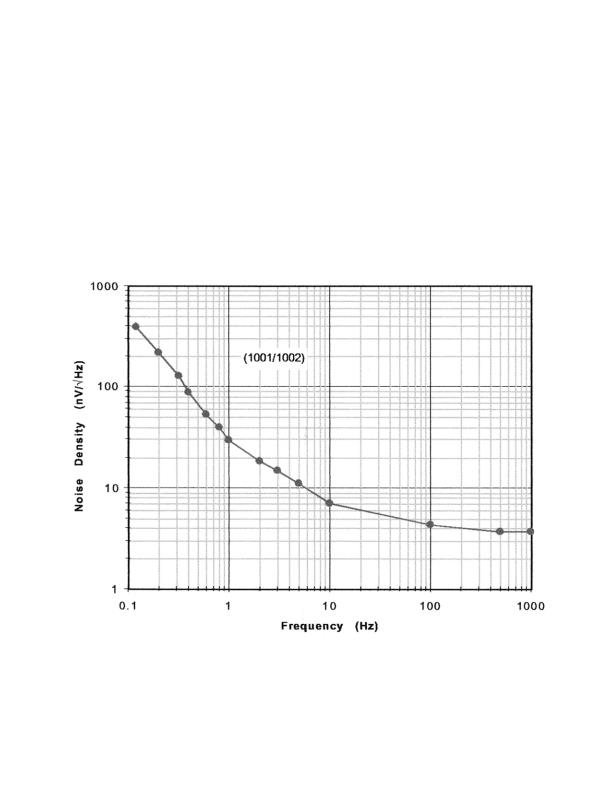- 您现在的位置:买卖IC网 > Sheet目录61 > HMC1001-RC (Honeywell Microelectronics & Precision Sensors)SENSOR LINEAR MAGN 1 AXIS 8-SIP

HMC1001/1002/1021/1022
www.honeywell.com
7
For simpler circuits with less critical requirements for noise and accuracy, a single polarity pulse circuit may be employed
periodically (all sets or all resets). With these uni-polar pulses, several uni-polar pulses become close in performance to a
single bipolar set/reset pulse circuit.
NOISE CHARACTERISTICS
The noise density curve for a typical AMR sensor is shown in the figure below. The 1/f slope has a nominal corner
frequency near 10Hz and flattens out to a 3.8 nV/sqrtHz slope. This is approximately equivalent to the Johnson noise (or
white noise) for an 850 ohm resistor, the typical bridge resistance. To relate the noise density voltage to the magnetic
fields, use the following expressions:
For Vbridge = 5V and Sensitivity = 3.2mV/V/gauss, the bridge output (Voutput) is 16mV/gauss
The noise density at 1Hz is about 30nV/sqrtHz or 1.8 micro-gauss/sqrtHz
1/f noise (0.1 to 10Hz) = 30 * sqrt[(ln10/0.1)] nV = 64nV (rms) = 4 micro-gauss (rms) = 27 micro-gauss (pk-pk)
White noise (BW = 1kHz) = 3.8 * sqrt[BW] nV = 120nV (rms) = 50 micro-gauss (pk-pk)
发布紧急采购,3分钟左右您将得到回复。
相关PDF资料
HMC1021D
IC SENSOR MAGN HI TEMP CER 8DIP
HMC1042L-TR
2-AXIS MAG SENSOR 16 PIN LCC
HMC1053
SENSOR MAGNETIC 3-AXIS 16-PLCC
HMU-PJAT1K-A20R1
CONN MU ATTENUATOR FIXED 20DB
HOA1870-033
SENSOR INFRARED
HOA1873-013
SENSOR PHOTODARLINGTON NPN SLOT
HOA1874-011
SNSR OPTO TRANS 3.05MM TRANSM
HOA1877-002
SENSOR PHOTOTRANS NPN SLOTTED
相关代理商/技术参数
HMC1002
功能描述:SENSOR LINEAR MAGN 2AXIS 20-SOIC RoHS:否 类别:传感器,转换器 >> 磁性 - 霍尔效应,数字式开关,线性,罗盘 (IC) 系列:- 标准包装:1 系列:- 传感范围:20mT ~ 80mT 类型:旋转 电源电压:4.5 V ~ 5.5 V 电流 - 电源:15mA 电流 - 输出(最大):- 输出类型:数字式,PWM,8.5 位串行 特点:可编程 工作温度:-40°C ~ 150°C 封装/外壳:20-SSOP(0.209",5.30mm 宽) 供应商设备封装:20-SSOP 包装:Digi-Reel® 其它名称:AS5132-HSST-500DKR
HMC1002RC
制造商:HONEYWELL 功能描述:New
HMC1002-RC
制造商:Honeywell Microelectronics And Precision Sensors 功能描述:MAGNETIC SENSOR; Magnetic Field Min:-2G; Magnetic Field Max:2G; Leaded Process Compatible:Yes; Output Type:Differential; Resolution:40G; Sensitivity Range:3mV/V/G; Sensor Output:Voltage; Sensor Terminals:SMD ;RoHS Compliant: Yes
HMC1002-RC
制造商:Honeywell Sensing and Control 功能描述:MAGNETIC SENSOR OUTPUT TYPE:DIFFERENTIAL
HMC1002-TR
功能描述:SENSOR LINEAR MAGN 2AXIS 20-SOIC RoHS:是 类别:传感器,转换器 >> 磁性 - 霍尔效应,数字式开关,线性,罗盘 (IC) 系列:- 标准包装:1 系列:- 传感范围:20mT ~ 80mT 类型:旋转 电源电压:4.5 V ~ 5.5 V 电流 - 电源:15mA 电流 - 输出(最大):- 输出类型:数字式,PWM,8.5 位串行 特点:可编程 工作温度:-40°C ~ 150°C 封装/外壳:20-SSOP(0.209",5.30mm 宽) 供应商设备封装:20-SSOP 包装:Digi-Reel® 其它名称:AS5132-HSST-500DKR
HMC1010LP4E
制造商:Hittite Microwave Corp 功能描述:RF RMS PWR DETECTOR 3.9GHZ 24SMT
HMC1010LP4ETR
功能描述:RF Detector IC General Purpose 0Hz ~ 3.9GHz -50dBm ~ 10dBm ±1dB 24-VFQFN Exposed Pad 制造商:analog devices inc. 系列:- 包装:剪切带(CT) 零件状态:有效 频率:0Hz ~ 3.9GHz RF 类型:通用 输入范围:-50dBm ~ 10dBm 精度:±1dB 电压 - 电源:4.5 V ~ 5.5 V 电流 - 电源:50mA 封装/外壳:24-VFQFN 裸露焊盘 标准包装:1
HMC1013LP4E
制造商:Hittite Microwave Corp 功能描述:IC AMP SDLVA 67DB 24SMD